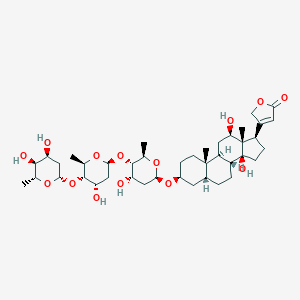| General Information of MET (ID: META00456) |
| Name |
Digoxin
|
| Synonyms |
Click to Show/Hide Synonyms of This Metabolite
12beta-Hydroxydigitoxin; AWD.pharma brand OF digoxin; Bertek brand OF digoxin; Boehringer, digoxina; Cardoxin; Cogoxin; Davoxin; Digacin; Digitalis glycoside; Digitek; Digoregen; Digoxin pediatric; Digoxina boehringer; Digoxine nativelle; Dilanacin; Dynamos; Eudigox', Homolle'S digitalin, 'Lanacrist; Glaxo wellcome brand OF digoxin; GlaxoSmithKline brand 1 OF digoxin; GlaxoSmithKline brand 2 OF digoxin; Hemigoxine nativelle; Kern brand OF digoxin; Lanacordin; Lanicor; Lanoxicaps; Lanoxin; Lanoxin PG; Lanoxin-PG; Lenoxin; Lilly brand OF digoxin; Mapluxin; Nativelle, digoxine; Nativelle, hemigoxine; Neo-lanicor; Novartis brand OF digoxin; Proctor and gamble brand OF digoxin; R.A.N. brand OF digoxin; Roche brand OF digoxin; Rougoxin; SK-Digoxin; Teofarma brand OF digoxin; UDL brand OF digoxin; Vanoxin; Virco brand OF digoxin
|
| Source |
Food;Plant;Metabolite;Food;Drug;Toxins/Pollutant;Plant Metabolite
|
| Structure Type |
Steroid lactones (Click to Show/Hide the Complete Structure Type Hierarchy)
Lipids and lipid-like molecules
Steroids and steroid derivatives
Steroid lactones
|
| PubChem CID |
|
| HMDB ID |
|
| Formula |
C41H64O14
|
| Structure |
<iframe style="width: 300px; height: 300px;" frameborder="0" src="https://embed.molview.org/v1/?mode=balls&cid=2724385"></iframe>
|
 |
|
3D MOL is unavailable
|
2D MOL
|
|
Click to Show/Hide the Molecular/Functional Data (External Links/Property/Function) of This Metabolite
|
| KEGG ID |
|
| DrugBank ID |
|
| ChEBI ID |
|
| FooDB ID |
|
| ChemSpider ID |
|
| METLIN ID |
|
| Physicochemical Properties |
Molecular Weight |
780.9 |
Topological Polar Surface Area |
203 |
| XlogP |
1.3 |
Complexity |
1450 |
| Heavy Atom Count |
55 |
Rotatable Bond Count |
7 |
| Hydrogen Bond Donor Count |
6 |
Hydrogen Bond Acceptor Count |
14 |
| Function |
Digoxin is a cardiac glycoside extracted from the foxglove plant, digitalis. It is widely used in the treatment of various heart conditions, namely atrial fibrillation, atrial flutter and congestive heart failure that cannot be controlled by other medication. Digoxin preparations are commonly marketed under the trade name Lanoxin. Digoxin has positive inotropic and negative chronotropic activity. It is used to control ventricular rate in atrial fibrillation and in the management of congestive heart failure with atrial fibrillation. Its use in congestive heart failure and sinus rhythm is less certain. The margin between toxic and therapeutic doses is small. (From Martindale, The Extra Pharmacopoeia, 30th ed, p666) -- Pubchem; Digoxin is a cardiotonic glycoside obtained mainly from Digitalis lanata; It consists of three sugars and the aglycone digoxigenin. Digoxin binds to a site on the extracellular aspect of the of the Na+/K+ ATPase pump in the membranes of heart cells (myocytes). This causes an increase in the level of sodium ions in the myocytes, which then leads to a rise in the level of calcium ions. The proposed mechanism is the following: inhibition of the Na+/K+ pump leads to increased Na+ levels, which in turn slows down the extrusion of Ca2+ via the Na+/Ca2+ exchange pump. Increased amounts of Ca2+ are then stored in the sarcoplasmic reticulum and released by each action potential, which is unchanged by digoxin. This is a different mechanism from that of catecholamines. -- Wikipedia; Owing to its narrow therapeutic index (the margin between effectiveness and toxicity), side effects of digoxin are inevitable. Nausea, vomiting and GIT upset are common, especially in higher doses. Decreased conduction in the AV node can lead to AV blocks, increased intracellular Ca2+ causes a type of arrhythmia called bigeminy (coupled beats), eventually ventricular tachycardia or fibrillation. An often described but rarely seen side effect of digoxin is a disturbance of color vision (mostly yellow and green color) called xanthopsia.
|
|
Regulatory Network
|
|
|
|
|
|
|
|
|
 click to show the details of this protein
click to show the details of this protein
 click to show the details of experiment for validating this pair
click to show the details of experiment for validating this pair

